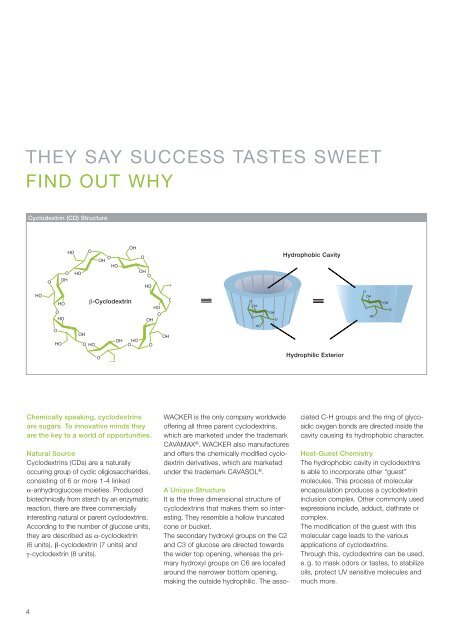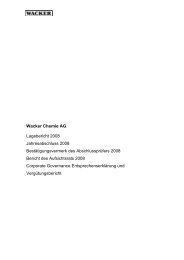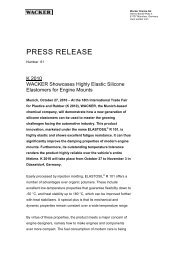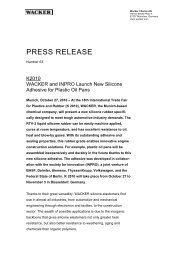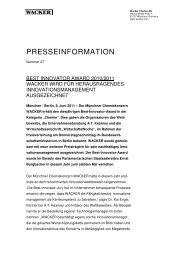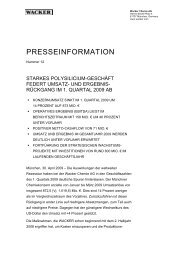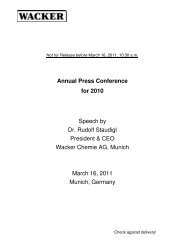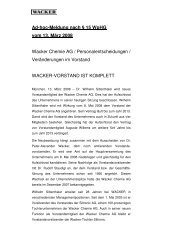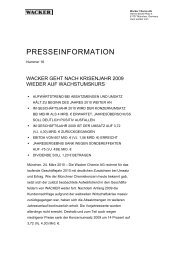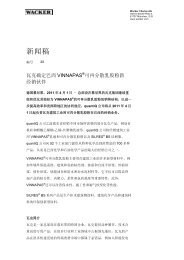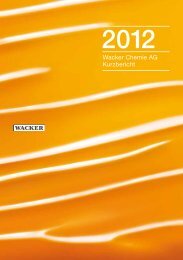CAVAMAX® AND CAVASOL® - Wacker Chemie
CAVAMAX® AND CAVASOL® - Wacker Chemie
CAVAMAX® AND CAVASOL® - Wacker Chemie
You also want an ePaper? Increase the reach of your titles
YUMPU automatically turns print PDFs into web optimized ePapers that Google loves.
THEY SAY SUCCESS TASTES SWEET<br />
FIND OUT WHY<br />
Cyclodextrin (CD) Structure<br />
Chemically speaking, cyclodextrins<br />
are sugars. To innovative minds they<br />
are the key to a world of opportunities.<br />
Natural Source<br />
Cyclodextrins (CDs) are a naturally<br />
occuring group of cyclic oligiosaccharides,<br />
consisting of 6 or more 14 linked<br />
aanhydroglucose moieties. Produced<br />
biotechnically from starch by an enzymatic<br />
reaction, there are three commercially<br />
interesting natural or parent cyclo dextrins.<br />
According to the number of glucose units,<br />
they are described as a-cyclodextrin<br />
(6 units), β-cyclodextrin (7 units) and<br />
γ-cyclodextrin (8 units).<br />
4<br />
HO<br />
O<br />
HO<br />
O<br />
HO<br />
O<br />
HO<br />
O<br />
OH<br />
HO<br />
HO<br />
OH<br />
O<br />
O HO<br />
O<br />
OH<br />
HO<br />
β-Cyclo dextrin<br />
O<br />
HO<br />
OH<br />
OH<br />
O<br />
OH<br />
O<br />
HO<br />
HO<br />
O<br />
OH<br />
HO<br />
O O<br />
OH<br />
OH<br />
O<br />
O<br />
OH<br />
WACKER is the only company worldwide<br />
offering all three parent cyclodextrins,<br />
which are marketed under the trademark<br />
CAVAMAX ® . WACKER also manufactures<br />
and offers the chemically modified cyclodextrin<br />
derivatives, which are marketed<br />
under the trademark CAVASOL ® .<br />
A Unique Structure<br />
It is the three dimensional structure of<br />
cyclodextrins that makes them so interesting.<br />
They resemble a hollow truncated<br />
cone or bucket.<br />
The secondary hydroxyl groups on the C2<br />
and C3 of glucose are directed towards<br />
the wider top opening, whereas the primary<br />
hydroxyl groups on C6 are located<br />
around the narrower bottom opening,<br />
making the outside hydrophilic. The asso<br />
O<br />
HO<br />
OH<br />
O<br />
Hydrophobic Cavity<br />
Hydrophilic Exterior<br />
O<br />
OH<br />
ciated CH groups and the ring of glycosidic<br />
oxygen bonds are directed inside the<br />
cavity causing its hydrophobic character.<br />
Host-Guest Chemistry<br />
The hydrophobic cavity in cyclodextrins<br />
is able to incorporate other “guest”<br />
molecules. This process of molecular<br />
encapsulation produces a cyclodextrin<br />
inclusion complex. Other commonly used<br />
expressions include, adduct, clathrate or<br />
complex.<br />
The modification of the guest with this<br />
molecular cage leads to the various<br />
applications of cyclodextrins.<br />
Through this, cyclodextrins can be used,<br />
e. g. to mask odors or tastes, to stabilize<br />
oils, protect UV sensitive molecules and<br />
much more.<br />
O<br />
HO<br />
OH<br />
O


